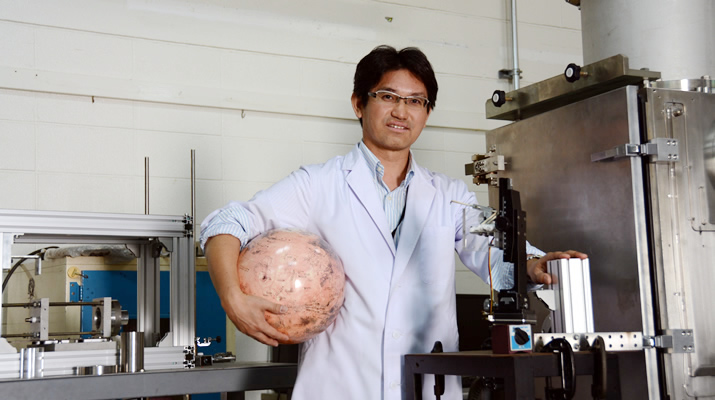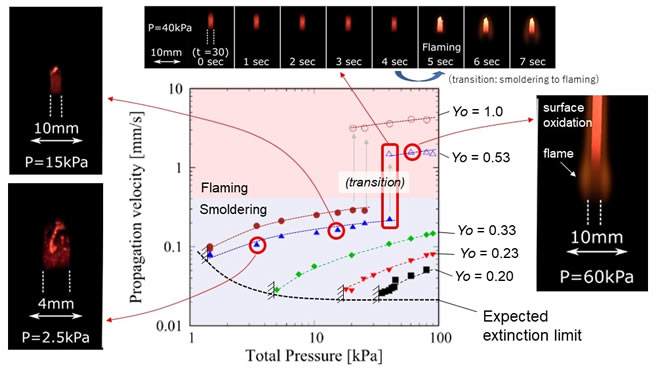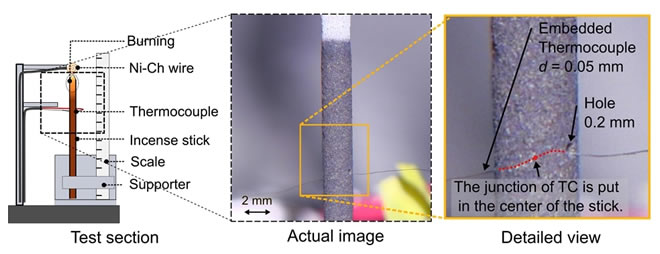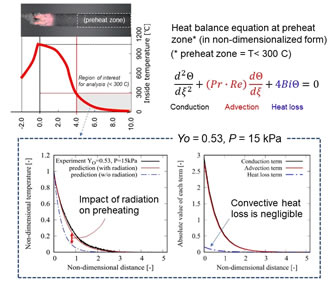
ここからコンテンツです。

Can we have a fire in a highly-vacuumed environment?
Towards better fire safety strategies for manned space missions By Yuji Nakamura
Yuji Nakamura and his research team at Toyohashi University of Technology have discovered that non-flaming combustion (smoldering) of a porous specimen can sustain itself, even at around less than 1 % of atmospheric pressure. The thermal structure of a 2-mm-diameter smoldering specimen, at a condition close to extinction, was successfully measured using an embedded ultra-fine thermocouple, clarifying the key issues that lead to fire extinction at low pressures. The outcome of this research will contribute to improved space exploration fire safety strategies.
Non-flaming combustion (i.e., smoldering) is an extremely slow burning process that emits toxic gas and white smoke during the burning event. This corresponds to the pre-flaming stage of burning a porous specimen, during which the blackened part grows, continuing the slow exothermic process. It eventually generates a flame that quickly accelerates the fire damage. Flaming combustion can be suppressed by reducing the pressure to nearly 1/3 of standard pressure (~30 kPa). Nevertheless, non-flaming combustion can sustain even at 1/100 of standard pressure (~1 kPa) if the ambient gas is fully-oxygenated. Extension of the critical pressure has been pointed out as an experimental fact; however, the actual reason is not known because it is extremely difficult to investigate the thermo-chemical status of near-critical conditions. Because the combustion intensity is very weak, sensor insertion may affect the status, resulting in failure to capture the actual physics.

A research group led by Professor Yuji Nakamura, from the Department of Mechanical Engineering at Toyohashi University of Technology, took on the challenge of measuring the temperature distribution of a smoldering thin rod in a pressure-controlled chamber at near-critical conditions. To make this possible, special care was taken to adjust the sensor while avoiding the potential failure described above. A tiny hole of 0.2-mm diameter was drilled through the fragile specimen. Then, a 50-micron R-type thermocouple was embedded into the hole. By achieving steady-state burning, even near the critical condition under a well-controlled experimental environment, a repeatable 1-D temperature profile was obtained along the axis.

The first author, Takuya Yamazaki, a PhD candidate, said, “The idea of drilling a miniscule hole into a small (2-mm) and fragile specimen such as the one we used, and then manually inserting a tiny thermocouple had never previously been considered. No doubt this was due to the high level of difficulty of such a procedure, which requires considerable patience and effort. Indeed I must admit that it was really exhausting to complete this task. Nevertheless, ultimately this process provided us sufficient insights into the near-critical condition thermal status to thoroughly understand the extinction mechanism. For instance, combustion heat is first transferred along the axis by radiation. After that, part of the transferred heat is lost to the ambient environment via natural convection when the total pressure is in the order of tens of kilo-pascals. Because the convective heat loss tends to be suppressed when the total pressure decreases, the heat transferred by radiation could remain in the specimen and so avoid extinction. Our success in being the first to demonstrate this fact by such a procedure is the fruit of our willingness to take on the ‘super’ challenge of measuring the precise temperature distribution of a smoldering specimen at near extinction.”

“The present results will make a contribution to fire safety basically thanks to Takuya’s personal devotion. This outcome suggests that the vacuumed operation to extinguish fire in space may fail unless the proper condition is achieved. Otherwise, smoldering may survive, causing a fire which may result in secondary damage to the cabin. This work is just the first step in constructing a tentative fire safety (regulation) strategy for outer space habitats in this age of privatized space development”, explains Professor Yuji Nakamura.
We use the term “smoldering” frequently, but, in reality, no one knows how a specimen burns to generate heat locally. It has been considered that surface oxidation is the source of heat generation, and that gas-phase reaction is not required to be considered. However, based on recent numerical predictions by a Chinese research team (a member of an international collaboration team led by Prof. Nakamura), it was found that a gas-phase gentle heat generation can support or promote surface oxidation. To further the cause of understanding smoldering at low pressures, another international collaboration team in the United States, also led by Prof. Nakamura, will assume the challenge of experimentally identifying the reactivity in the gas-phase. This is a crucial step, because up to now scant attention has been paid to the reaction status of the micro-pores of a burning specimen.
Funding agency: JSPS program “Overseas Challenge Program for Young Researchers”
Reference
Yamazaki, T., Matsuoka, T., and Nakamura, Y., "Near-extinction Behavior of Smoldering Combustion under Highly-vacuumed Environment", Proc. Combust. Inst., Vol.37, in print.
https://doi.org/10.1016/j.proci.2018.06.200.
極低圧下でも火種は消えない?
地球外空間での防災戦略への提言By 中村 祐二
豊橋技術科学大学機械工学系の中村教授らの研究チームは、極端に減圧した環境下でも炎を出さない燃焼が持続することを実験的に示すとともに、その理由を解明するための詳細計測に世界で初めて成功しました。低圧環境は宇宙船内や月面基地など、地球外環境の閉鎖空間の標準設定条件として頻繁に用いられるため、本研究成果は近い将来の有人ミッションにおける防災戦略に不可欠となる基盤情報を提供するものです。
線香やたばこのように、空隙を多く持つ固体物質は炎を出さずに緩慢な燃焼を実現することができます。この現象を「くん焼(燻焼. 無炎燃焼。スモルダリング)」と呼びます。布団に火種が与えられると、暫く「くすぶり状態」が続き、その後、突然炎が立ち上がって火災が急速に拡がりますが、くん焼とはこの「くすぶり状態(の燃焼)」に相当します。通常、炎を出して燃える場合、ある程度の酸素を遮断すると炎が保てなくなって消えてしまいます。そのためせいぜい大気圧の1/3程度(~30 kPa)まで減圧すれば炎は消失します。ところがくん焼の場合、遥かに低い圧力まで消えることはなく、純酸素(酸素100%)条件では、大気圧の1/100程度(~1 kPa)でもくすぶりが続きます。くん焼は「しぶとい」ことは経験的に知られているものの、なぜそのような悪条件でも燃え続けられるのかは未解明のままでした。その主な理由は、消える直前での燃焼強度は著しく弱く、温度センサを挿入するとそれがきっかけで燃焼状態を変えてしまうからです。
本研究では、その未解明な問題に挑戦すべく、センサ挿入に伴う熱影響が無視できる条件を抽出し、消える直前の温度分布を高精度で計測することに世界で初めて成功しました。具体的には線香に直径0.2mmの穴をあけ、そこに極細の温度センサ(自作)を埋め込み、消炎限界付近でも定常燃焼させるような安定性の高い空間を設けることでそれを実現しています。
「脆い2mmの線香にドリルで0.2mmの穴を空けること自体、容易ではありませんが、さらにその中に極細の温度センサを埋め込み、試験チャンバ内部に正しく配置することは、表現し難い苦労を伴います。実際、1度の計測準備に相当時間がかかります。温度計測をしないと燃えた・燃えないという事実しかわかりませんが、限界近くの温度計測を成功させたことで、線香のような粒度の細かい材質で構成された多孔質材であっても、発熱部の数mmにある予熱部まで輻射による熱輸送がありそこから周囲空気に対して熱が逃げて消炎に至ること、減圧すると熱の逃げが少なくなり、予熱分はそのまま燃焼促進をもたらす可能性を指摘しました。たかが温度分布、されど温度分布です」と筆頭著者である博士後期課程の山崎拓也は説明します。
研究チームのリーダーである中村祐二教授はこう結びます。「世界に相当数の燃焼研究者がいても、わずか直径2mmの脆い燃焼試料に極細穴を開け、そこに極小センサを埋め込んで消炎状態を直接計測しようとする人はおらず、ましてや、それを実現した人はいない。他の人がやら(れ)ないことに挑戦しない限り、誰よりも先の結果を知ることができない。山崎くんの好奇心、職人ばりの技術、くじけない根性はそれを実現してくれました。宇宙空間での消火対策として、キャビン内のガスを機外に出し、内圧を低下させて消火させる防災対策が検討されていますが、減圧してもくん焼状態を持続していた場合、消えたと思って圧力回復したときに突然炎が立ち上がるという火災の二次被害がもたらされる可能性があります。そのため、くん焼が持続できない条件を明確にすることは、宇宙での防災戦略にとても重要な意味を持ちます。今後、民間主導で宇宙開発が進むと期待されていますが、低圧火災の研究を通じて想定外の事故を未然に防ぐことに貢献したいと考えています。」
くん焼は空隙の中で緩慢に化学反応が進行するとされていますが、実はそれがどのようになっているのか誰も見たことがありません。このように、現象は馴染みがあるものの、実は発熱機構すら十分にわかっていないのが実体です。最近、共同研究先の海外研究チームが「空隙内のごく弱い気相反応が空隙表面での酸化反応を強化する」可能性を数値解析にて予測しました。果たしてこれが正しいか否か、これから米国の共同研究チームと連携して空隙内での反応状況のセンシングを試みる予定です。もちろん、そのようなマイクロメータオーダの空隙の中での反応状況を検知しようとする発想は斬新であり、「誰もやら(れ)ない新たな課題への挑戦」は続きます。
Researcher Profile

| Name | Yuji Nakamura |
|---|---|
| Affiliation | Department of Mechanical Engineering |
| Title | Professor |
| Fields of Research | Combustion, Fire, Scale Modeling, Space Engineering |
ここでコンテンツ終わりです。
